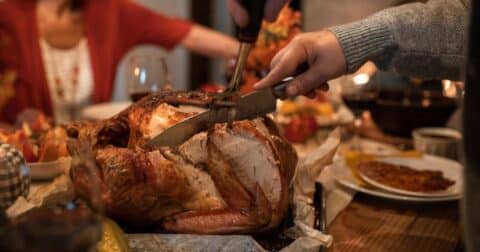Fact Check
There Is Nothing Especially Healthy About Regenerative Meat
Health•4 min read
Perspective
From animal welfare to environmental impact, here are some reasons to opt out.

Perspective • Diet • Health

Words by Gabriella Sotelo
Historians are still unsure if turkey meat was served at the first Thanksgiving, but nonetheless, these affectionate and social birds have been considered a Thanksgiving staple for centuries. The United States Department of Agriculture (USDA) reports that nearly 218 million turkeys are produced each year. Of those, about 46 million turkeys are killed for Thanksgiving meals, according to the USDA.
Domestic turkeys, the ones you find in supermarkets for Thanksgiving, can live for up to 10 years. These oversized turkeys are not bred to live long-term; they are slaughtered between 12 weeks and five months old.
Modern factory-farmed turkeys are selectively bred to produce more meat, and grow so big that they can’t walk or breathe properly. These birds cannot even mate on their own; they are forcibly artificially inseminated. Today, turkeys are twice the size of turkeys from less than 100 years ago.
Turkeys endure immense suffering, physically and mentally, before ending up on a platter. They are stripped of their natural environments, treated poorly and slaughtered in horrific ways.
Here are the reasons animal rights activists argue you should not eat turkey this Thanksgiving.
On your Thanksgiving plate, turkey contributes about 1.49 kg of CO2 emissions per serving. This highlights the environmental footprint of poultry production, despite its lower emissions compared to other meats. People also waste around 35 percent of the turkey meat they were going to eat for Thanksgiving.
Though turkey only produces around one-tenth of the emissions that beef does, there are a variety of impacts that turkey production has on the environment. For example, phosphorus, found in poultry manure, can pollute nearby water sources and fuel harmful algae growth.
In the wild, turkeys forage, build nests and roam around their natural territories, which often stretch over 1,000 acres. Domestic turkeys bred for meat, on the other hand, are forced to live in cramped conditions with as little as 2.5 cubic feet per bird.
Due to the high-stress environments in which young turkeys live, aggressive behavior is common. But instead of raising turkeys in less crowded conditions, farmers reduce the risk of turkey-inflicted injury by trimming off their beaks, cutting off their toes and slicing off their snoods — the red dangling skin that hangs over a turkey’s beak — without anesthetics.
Conditions inside factory farms are cramped, stressful and filthy. Infections are common, since thousands of birds are packed into one common living space without proper care. Some turkeys suffer from skin infections after being pecked by other birds, which is a common behavior on industrial farms.
Often, the large buildings housing turkeys are not properly cleaned, so birds are forced to live in their own excrement. As a result, ammonia levels rise, and birds can develop painful burns and lesions on their feet and legs. The ammonia can also negatively impact turkeys’ respiratory health. Excessive ammonia exposure can also cause hemorrhaging in the birds’ tracheas and bronchi, as well as the thickening of atrial walls and shrinking of air capillaries in their lungs.
Turkey meat recalls are not uncommon, despite the excessive use of antibiotics by farmers. In October 2024, the meat producer BrucePac recalled 11,765,285 pounds of ready-to-eat meat and poultry products that may have been contaminated with listeria. This included ready-to-eat turkey products at major stores like ALDI and Trader Joe’s.
This pattern goes back years and years: In March of 2019, the popular turkey producer Butterball recalled nearly 80,000 pounds of raw ground turkey products due to a salmonella outbreak. A few months prior, in December of 2018, turkey producer Jennie-O recalled approximately 164,210 pounds of raw ground turkey for the same reason. In November of 2018, just weeks before Thanksgiving, Jennie-O had recalled another 147, 276 pounds of raw ground turkey products.
Industrial turkey production often overuses antibiotics in order to prevent bacterial infections, which contributes to antimicrobial resistance. These antibiotics are meant to stop the spread of salmonella, listeria, campylobacter, E. coli and other bacteria to humans. Yet drug-resistant strains of these bacteria are infecting people around the country.
When that happens, harmful bacteria that were once treatable can cause serious illness and even death. The previously mentioned 2018 recall of Jennie-O turkey products, for example, resulted in one fatality, 133 hospitalizations and 358 individual cases of salmonella across 42 states. As antibiotic-resistant bacteria get stronger, more human lives will be endangered.
Intensive turkey production can also contribute to the spread of bird flu, because of the confined conditions in which turkeys spend their lives. Avian flu can then spread to other mammals, like humans, who are in close contact with infected birds.
Over 200 million turkeys are slaughtered each year in the United States, and 99 percent of them are raised on factory farms. Inside these large industrialized buildings, up to 10,000 turkeys are crammed into a single barn. Most industrialized farming operations hold around 55,000 turkeys at a time.
A guide from the Humane Slaughter Association provides step-by-step instructions on how to slaughter animals “humanely.” A “killing cone” is used to keep animals from squirming too much while they’re being slaughtered. This method sometimes fails to make the birds unconscious quickly, and can make breathing difficult and uncomfortable for larger birds.
Electrical stunning is often used to render birds unconscious before slaughter, which can cause some animals to respond with “epileptic-like fits.”
Other terms that appear in the humane slaughter handbook include concussion stunning followed by neck cutting, neck dislocation and gas killing. Concussion stunning “involves the application of a severe blow to the skull to cause immediate unconsciousness, or, if sufficient force is applied, death. This must be followed by neck cutting or neck dislocation to ensure the death of the bird.”
Turkeys in the U.S. can either be stunned using carbon dioxide stunning or electrical stunning. The latter method consists of shackling live turkeys by their ankles, which requires force that usually breaks their delicate bones, and running them along a conveyor belt into electrically charged water. This water is supposed to render them unconscious, but electrical currents can sometimes be too low, meaning turkeys are fully conscious while getting their throats slit by a rotating blade. Sometimes turkeys miss the blade, which results in dumping them into scalding hot water tanks, which are used to loosen their feathers for defeathering.
The Humane Slaughter Act was passed by the USDA Food Safety and Inspections Service (FSIS) branch in 1978 to require “humane” handling of animals before and during slaughter. But this act does not apply to turkeys or chickens. Poultry birds and factory-farmed animals, in general, have virtually zero legal protections.
In industrial agriculture, expectations are high to work quickly and process as much meat, milk or eggs as possible. When production speeds are increased, animals are not the only ones who are injured; the physical and mental health of workers is often compromised.
In 2018, the Guardian and the Bureau of Investigative Journalism compiled data from U.S. meat plant workers and found that “amputations, fractured fingers, second-degree burns and head trauma” are among the potential injuries workers face every day. Records gathered from the Occupational Safety and Health Administration (OSHA) showed that on average, 17 severe accidents — meaning workers were hospitalized, lost an eye or needed an amputation — occur each month at slaughterhouses and other animal facilities around the country.
According to the data, amputations occur twice per week, on average. From 2015-2017, 270 incidents were documented which involved the amputation of fingers or fingertips, hands, arms or toes. When production speeds are at the top of the priorities list, workers are bound to get hurt. Increased production pressures negatively impact the animals as well; courtesy goes out the window as workers are expected to process hundreds of birds per day.
In the wild, turkeys form immediate bonds with their young, much like humans. Once their eggs are soon to be hatched, mother turkeys do not leave the nest unless they are forced to. When the babies are born, turkey moms keep them close by, under their wings, until they are old enough to forage on their own.
Some baby birds, like raptors and songbirds, wait in the nest while their mothers forage for food. But it is unusual for turkey mothers and their babies, called poults, to be apart. Poults will panic if they’re separated from their mothers for too long, and cry out until she finds them. These babies snuggle under their mothers’ wings for comfort and shelter throughout the day, and sleep under them at night. In industrialized farming, however, they have no chance to.
Turkeys form strong bonds with their flockmates, and even with humans and other animals. They enjoy playing with round objects they can kick and roll, and are naturally very curious. Similar to humans, turkeys can recognize each other based on their own unique calls.
Turkeys in industrialized farms, on the other hand, don’t get the opportunity to spread their wings, run around in the grass or live out their lives naturally. These birds are forced to live in dark, overcrowded buildings before they are ultimately slaughtered.
People often believe turkeys are unintelligent. But turkeys are actually much more intelligent than they get credit for. They are social birds who possess many vocalizations to communicate with each other. They can actually recognize each other based on their unique voices.
Turkeys travel in flocks, and if one strays away from the group, they will be stressed and continue calling out until they’re reunited. When content, turkeys will purr or cluck excitedly. Wild turkeys are also exceptional land navigators. Their natural territories often stretch over 1,000 acres, and they can recall and find feeding locations from years prior.
Plant-based turkey alternatives have rapidly improved over the past few years. Plant-based turkey brands like Tofurky, Gardein, Quorn and Field Roast can be found in most large grocery stores. The Internet is flooded with simple turkey alternative recipes, as well as side dish recipes. With turkey costs rising, plant-based alternatives can also be more affordable.
Each year, millions of turkeys are raised and slaughtered for Thanksgiving, enduring inhumane conditions in factory farms. Beyond the animal welfare issues with this, the turkey industry also has significant environmental impacts. When alternatives exist, the reasons to forgo turkey are plentiful.